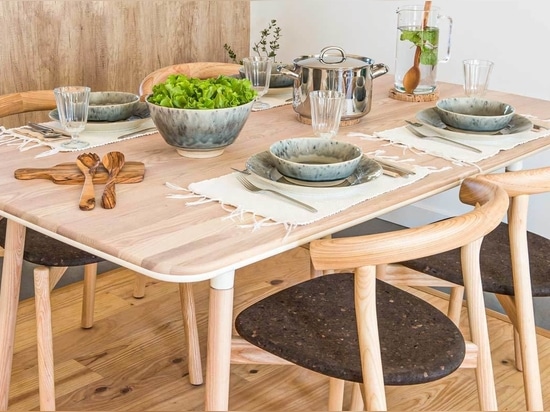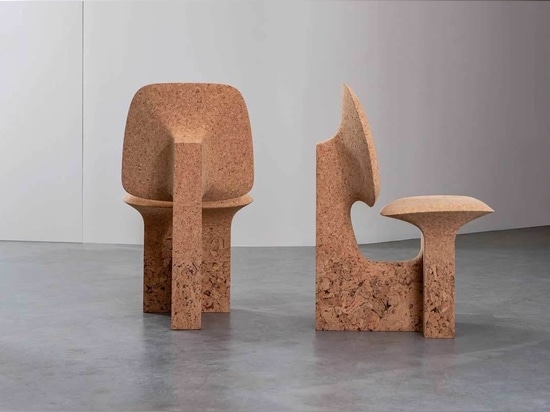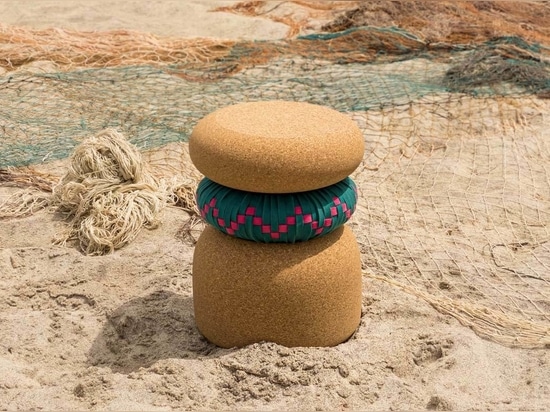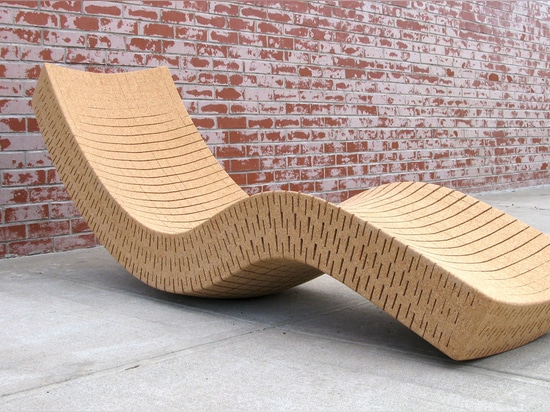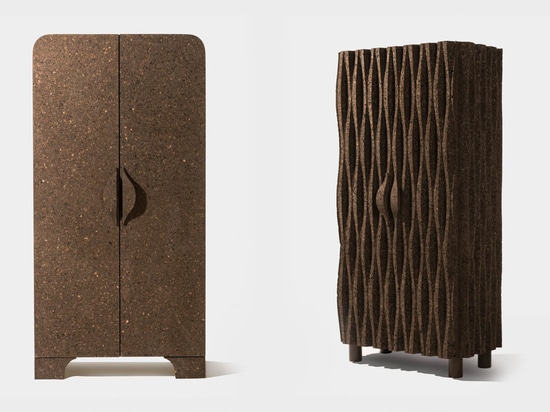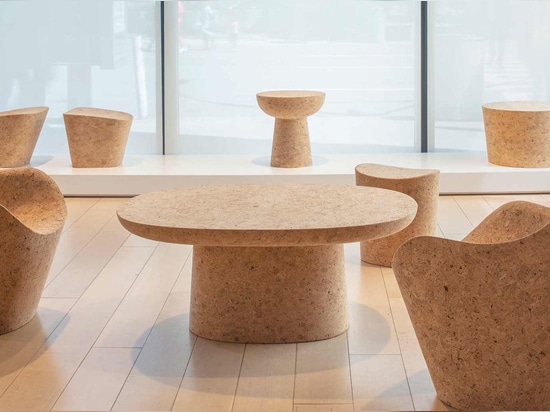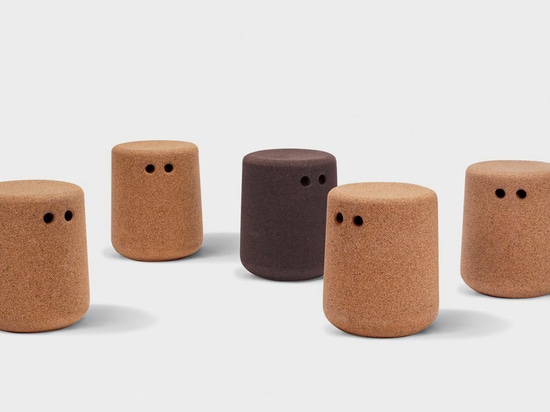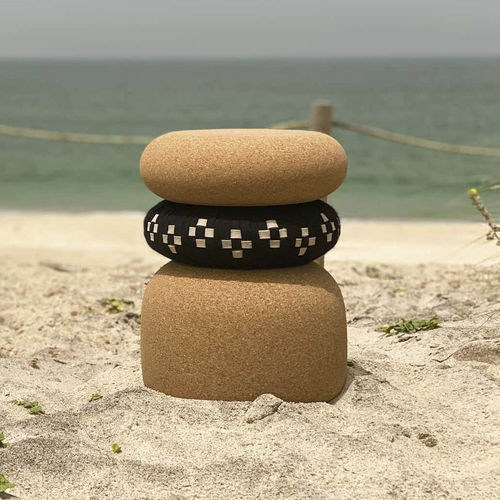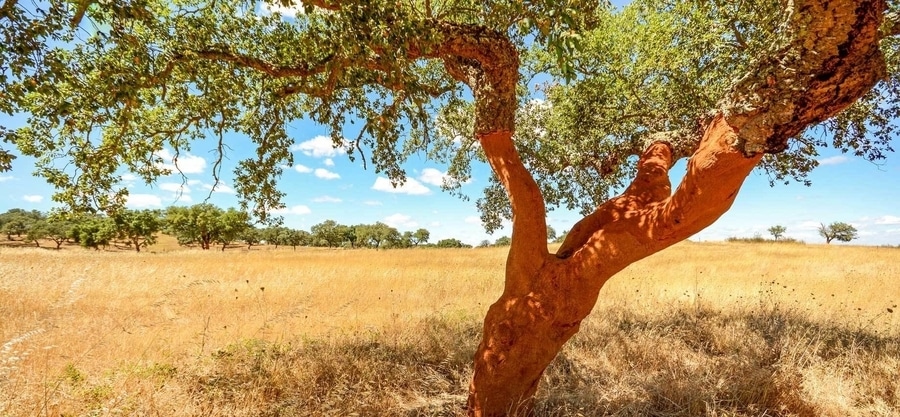
#Inspiration
Cork furniture products: 6 reasons why you should use cork furniture
Cork furniture products are a growing trend?
Cork may be best known for its history with wine and the office pinboard, but in reality, it is an incredibly green and versatile material when applied to interiors. This is why cork is one of the materials we love most. Cork furniture products are good for health and environment. Know 6 reasons to start using cork furniture and let yourself be inspired by some examples.
Cork furniture products are a growing trend?
Today, many design projects are directed by ethical and sustainable initiatives and architects and designers are choosing cork as a leading building and interior material. But Jasper Morrison was one of pioneer in this field: he designed the Cork Family for Vitra in 2004, a range of playful stools for the long-established brand.
In many other cases, cork furniture pieces look as if they have been carved out of one block, with a soft yet textured surface that still provides a variety of shades. Organic curves, interesting grain, striking shapes: cork offers the same advantages as the natural material wood, but combined with the flexibility of plastic. Aesthetically cork, like hardwood timber floors, has a raw and timeless appeal as it is sourced from nature itself. No piece is the same, offering a multitude of grain, texture and color finishes.
“Cork is a natural material with wonderful haptic and olfactory qualities with the versatility to be carved, cut, shaped and formed”. (Herzog & de Meuron, architects)
The cork material is water-repellent, antiallergenic, easy to clean and both malleable and hard-wearing. Cork feels pleasant to the touch, exudes a comforting scent and boasts heat- and sound-insulating properties. As a result, cork furniture quickly creates a special and cozy atmosphere. Craveiral Farmhouse is an example of that.
6 reasons why you should use cork furniture
1. Cork furniture is eco-friendly
Cork is a natural raw material which is 100% biodegradable, recyclable and renewable. Cork’s innate renewability is considered its finest feature as it can be harvested from the outer bark of the cork oak tree (Quercus Suber) without causing harm and leaving the tree to regenerate. Cork trees, generally found in Mediterranean countries, are slow growing and can live up to 250 years with the harvesting cycle typically occurring every nine years. According to the World Wildlife Federation, a cork tree that has its bark removed every nine years will absorb up to five times as much CO2 than a similar tree that is left idle. So, using cork furniture helps against climate change. Discover how to create sustainable interior design here.
2. Cork furniture is good to health
Research carried out by the University of Porto in Portugal reveals that cork has antioxidant and anti-carcinogenic properties. Furthermore, cork is naturally antimicrobial which assures a great promise in deteriorating mold, mildew, termites and other harmful insect infestations. Cork’s antistatic surface limits the chance of dust and toxin absorption, making it a great choice for people with allergies. Finally, when it is applied to furniture, cork products contribute to improving the Indoor Air Quality. EPA suggests that indoor air quality is often 2-5 times more polluted than outdoor air quality. Given that we spend 90% of our time indoors, purchasing furniture that’s good for the environment and our personal health is important.
3. Cork furniture is durable
Cork has been known to last up to 50 years when used in interiors thanks to its resilience to pressure, which makes it very suitable for high traffic areas. For example, the PIPO stool is suitable for different types of spaces, never goes out of fashion, it is easy to clean and is resistant because it is made from a massive block cork.
4. Cork furniture is comfortable and soft to the touch
Cork is very soft to the touch, with a very unique odor, that is not intrusive and is slightly sweet. With a normal temperature very close to that of the human body, cork emits a sense of comfort that is hard to replicate with any other material. For example, the DINA chair by DAM has a cork seat which is comfortable both in winter and summer due to the mild temperature of the cork material. it is also not too hard or soft, making it both resistant and comfortable.
5. Cork furniture is fire retardant / non-toxic
The slow combustibility of cork makes it a natural fire retardant. Cork is therefore a natural barrier against fires. Cork burns without a flame and does not emit toxic gasses during its combustion.
6. Cork furniture is suitable for outdoor
Thanks to the suberin and ceroids, cork is practically impermeable to liquids and gasses. This resistance to moisture, and therefore to subsequent oxidation and decay, enables the cork furniture to age without deteriorating and to be suitable for outdoor use. For example, DUO table is only made of composite cork, so is washable and waterproof; and it is still finished with colorless aqueous coating with properties of water repellency, oil, and stains and high resistance to UV and aging, keeping the natural touch and breathability of cork.
Facts and Curiosities about Cork
Where does cork come from?
Cork is the bark of the cork oak tree – Quercus Suber L. – which means that it is 100% natural plant tissue. Cork oak tree is a millenary tree that grows in the Mediterranean basin. The largest areas of cork oak forest are in Portugal, Spain, Italy, France, Morocco, Tunisia and Algeria. But Portugal is the place that always had favorable climatic conditions to grow oak tree plantations. The world’s production of cork is 340,000 tonnes per year, 55% of which is from Portugal. The cork sector assumes an especially important role in economic, social and environmental terms in Portugal, where the cork oak tree is the National Tree and occupies 22% of the country’s forest area.
What is cork made of?
Its one-of-a-kind chemical structure makes cork one of the most mind-blowing materials on earth. The cork cells, grouped in a honeycomb structure similar to a beehive, are filled with a mixture of gases that very similar to air, and their walls are primarily covered with suberin (a kind of natural wax) and lignin (a three-dimensional microcell that is resistant to microbiological attacks). Other compounds are identified in its chemical composition, although in less quantity, such as polysaccharides, ceroids and tannins. A single cubic centimeter of cork contains nearly 40 million cells. There are 800 million cells in a single cork stopper. The incredible combination of the gas mixture similar to air with the suberin gives cork its unique properties. Lightness, because cork is filled with gas, but also elasticity and compressibility, since cork is a combination of micro balloons, or micro pillows, gently pressing against each other.
Chemical Composition of Cork:
- 45% Suberin (main component of the cell walls, responsible for the elasticity of the cork);
- 27% Lignin (insulating compound);
- 12% Cellulose, Waxes, other Polysaccharides (components of the cell walls that help define the texture of the cork);
- 6% Tannins (polyphenolic compounds responsible for the color);
- 6% Ceroids (hydrophobic compounds that guarantee the impermeability of the cork).
Does the cork oak need to be cut down to harvest the cork?
No. Stripping is carried out manually and the trees do not have to be cut down. In fact, the cork oak undergoes a self-regeneration process of the bark, which gives the activity of cork harvesting a uniquely sustainable nature. In each cork harvest, it is possible to extract an average of 40-60 kg of cork per cork oak tree.
Did you know that cork production plays an important role in regulating the climate?
The cork oak forest’s ecosystems play an important role in climate regulation. During photosynthesis, plants capture CO2 from the atmosphere, releasing oxygen and retaining carbon. The cork oak trees live for an average of 200 years. Since the tree is not felled during extraction of the cork, and the process has negligible effects on carbon retention, the cork oak is able to retain carbon throughout its life cycle. For every one ton of cork produced, cork oak forests capture and store up to 73 tons of CO2.
Let yourself be inspired by some cork furniture products
The art of design is creating attractive, safe, functional and comfortable contemporary furniture without wasting natural resources. Now, let yourself be inspired by some cork furniture products.
The Burnt Cork collection by the Made in Situ design studio combines flowing designs with motifs from nature, and it’s an ode to the traditional Portuguese craft of cork production. From calcined bark to fine grain, from rawness to fluid curves, the BURNT CORK was developed by the French designer Noé Duchaufour-Lawrance.
DAM is a Portuguese furniture brand that promotes storytelling and sustainability since 2013. The DAM products are made of natural materials, specifically the Portuguese cork, light cork and black cork. The newest product launched by DAM is the VARINA table, made of composite light cork and hand-interlaced felt waste. This small cork table represents the women called “VARINAS” from Ovar, in Portugal, who went by train to Porto and Lisbon with a wheel on the head, carrying the basket, to sell fish.
Daniel Michalik uses cork as an experimental interior material, creating objects that explore all the characteristics of it. Daniel has a great relation with the Portuguese producers that gave him even more knowledge of the material itself but It is in New York City that he explores, and experiments from a scientific standpoint new ways of using this sustainable material.
In 2018, Campana Brothers created a group of pieces of furniture that explores the beauty, versatility and sustainability of cork. Made up of an armchair and three cabinets, the collection marked the participation of the Brazilian designers in the 2018 edition of Experimenta Portugal, an arts and culture festival.
In 2019, Jasper Morrison launched a range of edition furniture made of cork, designed for the Kasmin Gallery in New York.
Based in London, Modus developed contract furniture for over two decades and also includes some cork furniture pieces in the portfolio. One of them is the Bob stool with an enigmatic personality. Developed by Michael Sodeau, it is available in light and black cork.
